20.4: Long-Run Growth
- Last updated
- Save as PDF
- Page ID
- 3564

- Boundless
- Boundless
Determinants of Long-Run Growth
Long-run growth is defined as the sustained rise in the quantity of goods and services that an economy produces.
learning objectives
- Predict how population growth will affect the level of capital per worker
Long-Run Growth
Economic growth is the increase in the market value of the goods and services that an economy produces over time. It is measured as the percentage rate change in the real gross domestic product (GDP).
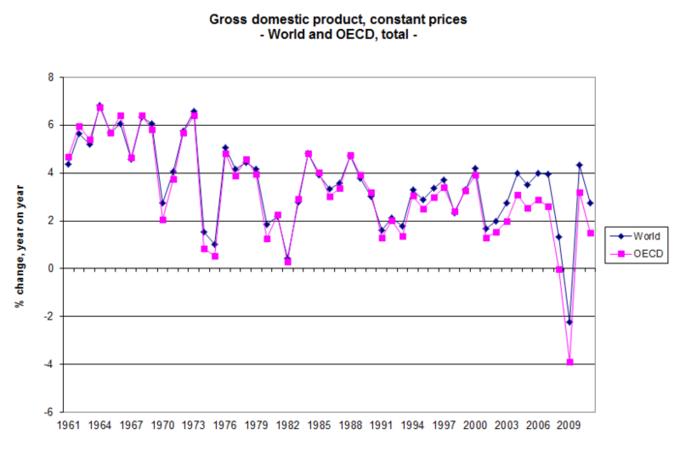
Measuring the GDP: Economic growth is the percentage rate increase in the GDP. Long-run growth is directly impacted by the GDP.
Long-run growth is defined as the sustained rise in the quantity of goods and services that an economy produces. The GDP of a country is closely tied to the growth of the population in addition to prices and supply and demand.
Determinants of Long-Run Growth
There are specific determinants that impact the long-run growth of an economy:
- Growth of productivity: is the ratio of economic outputs to inputs ( capital, labor, energy, materials, and services). When the productivity increases the cost of goods is lowered. Lower prices increase the demand for the product or service. An increase in demand can lead to higher revenue.
- Demographic changes: demographic factors influence economic growth by changing the employment to population ratio. Factors include the quantity and quality of available natural resources. Age structure of the population also influences employment and long-run growth.
- Labor force participation: the amount of labor force participation and the size of economic sectors influence economic growth. The labor force participation is the amount of workers available. In countries with high development and industrialization, labor force participation is high because of low birth and death rates.
Inflation and Excessive Growth
When the economic growth matches the growth of money supply, an economy will continue to grow and thrive. In this case, population growth would increase, but the need for goods and services would also increase. As a result, more jobs would be available and the employment rate would also increase.
However, when economic growth is not balanced, the result can include inflation and excessive growth. Inflation occurs when the price of goods and services are rising which causes purchasing power to fall if wages don’t also rise. A decrease in the demand for goods and services will lead to a decrease in revenue and employment. A high rate of population growth will cause less capital per worker, lower productivity, and lower GDP growth.
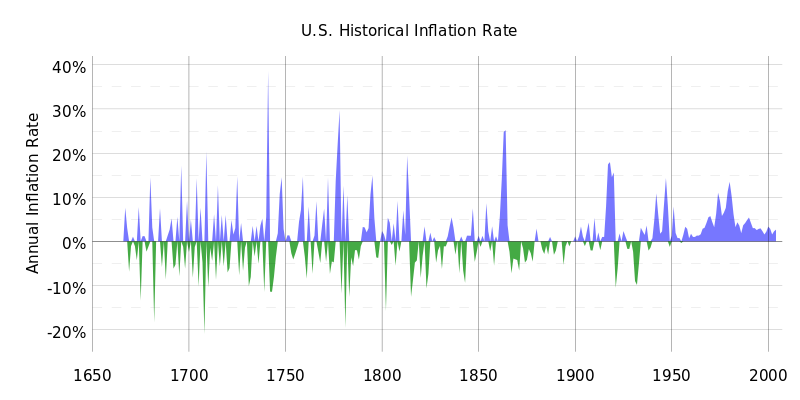
Inflation: Inflation occurs when the price of goods and services are rising which causes purchasing power to fall if wages don’t also rise. Inflation is a negative effect of economic growth that is not balanced.
When the GDP growth is only caused by increases in population (not increases in supply, demand, revenue) the growth is excessive. In order for an economy to be successful, it must meet the needs of the population (supply, demand, revenue, and employment). When a population grows too fast the economic system cannot support the changes. Excessive growth leads to an imbalance in supply and demand and higher levels of unemployment. The quality of living decreases when the economy cannot support the population growth.
Aggregate Production
The aggregate production function examines how the productivity depends on the quantities of physical capital per worker and human capital per worker.
learning objectives
- Discuss how aggregate production impacts long-run growth
Aggregate Production
The aggregate production function examines how productivity, or real GDP per worker, depends on the quantities of physical capital per worker and human capital per worker. The production function relates the physical outputs of production to the physical inputs or factors of production. The aggregate production takes the physical outputs and inputs into account to determine the allocative efficiency of the economy as a whole.
Aggregate production functions create an estimated framework to determine how much of an economy’s growth is related to changes in capital or changes in technology. Production functions assume that the maximum output is attainable from a given set on inputs. The aggregate production function describes the boundary representing the limit of output attainable from each feasible combination of input.
To understand how the aggregate production impacts long-run growth, it is important to understand the stages of production:
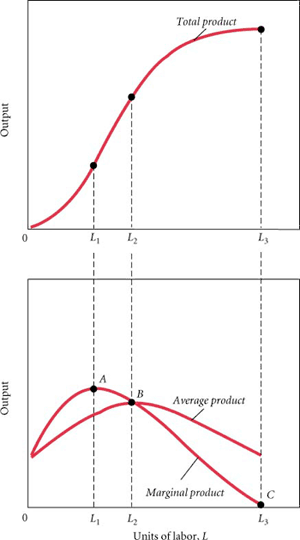
- Stage 1: the variable input is being used with increasing output per unit. The average physical product is at its maximum.
- Stage 2: output increases at a decreasing rate and the average and marginal physical product are declining. The average product of fixed inputs are still rising. The optimum input/output combination will be reached.
- Stage 3: variable input is too high relative to the available fixed inputs. The output of both fixed and variable input declines.
Aggregate Production and Long-Run Growth
The long-run growth of a firm can change the scale of operations by adjusting the level of inputs that are fixed in the short-run, which shifts the production function upward as plotted against the variable input. Aggregate production functions study the short-run inputs and outputs of a firm or economy. The results allow adjustments to be made which improves the long-run growth by balancing the inputs and outputs.
Changing Worker Productivity
In economics and long-run growth, worker productivity is influenced directly by fixed capital, human capital, physical capital, and technology.
learning objectives
- Examine the role of human capital in production and economic growth
Worker Productivity
In economics and long-run growth, worker productivity is influenced directly by fixed capital. The four types of fixed capital include: useful machines, instruments of the trade; buildings as the means of procuring revenue; improvements of land; and the acquired and useful abilities of all the inhabitants or members of society.
One way to increase worker productivity is to invest in better machinery, for example. A worker with a more productive tool in more productive.
Another way to increase productivity is to find ways to increase the revenue of the product generated by the workers. Since productivity is measured in dollars per worker, being able to generate more revenue from the same output is reflected in an increase in worker productivity.
Perhaps most interesting, though, is how to change worker productivity through human capital.
Human Capital
Human capital is defined as the stock of competencies, knowledge, social and personal attributes, including creativity, embodied in the ability to perform labor so as to produce economic value. Many economic theories tie education to economic growth explaining that it is an investment in human capital development. Human capital has been shown to increase economic development, productivity growth, and innovation.
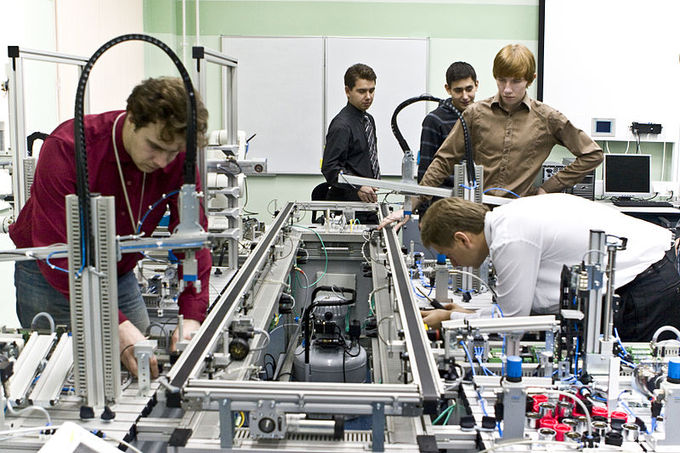
Education: Education increases human capital and worker productivity.
A human resource is transformed into human capital with the effective inputs of education, health, and moral values. When individuals and societies invest in human capital it strengthens the future of the long-run economic growth. The qualitative and quantitative progress of a country is inevitable when human development is a priority. Over time, when worker productivity increases the quality and quantity of the goods and services will also increase.
Importance of Worker Productivity
When a society invests in human capital, it increases worker productivity and economic growth. Human capital and increased worker productivity are critical because they are different from the tangible monetary capital or revenue. It is important thought that an economy recognizes the importance of monetary capital. Worker productivity in the long-run is related to real income. If the real income falls over time it will negatively impact worker productivity. Economic revenue goes up and down due to shocks in the business cycle. Human capital grows cumulatively over a long period of time. When a society focuses on human capital and in turn worker productivity, the long-run economic growth will be steady. Economic inputs towards education, health, and worker productivity impacts future generations by ensuring that they will be more advanced and efficient than the current generation. The increase in worker efficiency is the direct result of a superior quality of manpower created through increased human capital.
Technological Change
In economics, technological change is a term used to describe the change in a set of feasible production possibilities.
learning objectives
- Assess the value of technology to a nation’s economic growth
Technological Change
In economics, growth is defined as the increase in output per capita of a country over a long period of time. One primary factor that influences the growth of an economy is technological change. Technological change is a term used to describe the change in a set of feasible production possibilities. Technological improvement has the ability to increase the amount of output an economy can produce, even if the level of inputs remains constant.
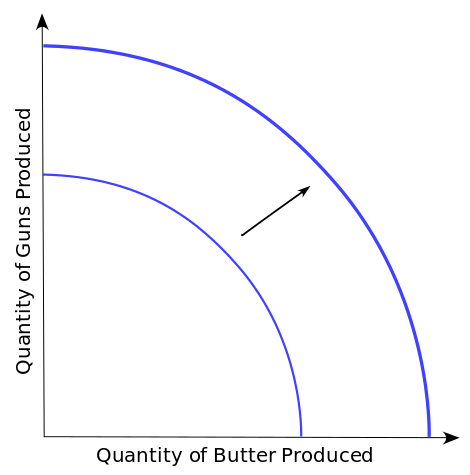
Technological Change: Technological change causes the production possibility frontier to shift outward and initiate economic growth.
Technology and Long-Run Growth
Technology is defined as the making, modification, usage, and knowledge of tools, machines, techniques, systems, and methods of organization in order to solve a problem, improve a preexisting solution to a problem, or achieve a goal. In economics, improvements in technology have helped develop more advanced economies (for example, today’s global economy).
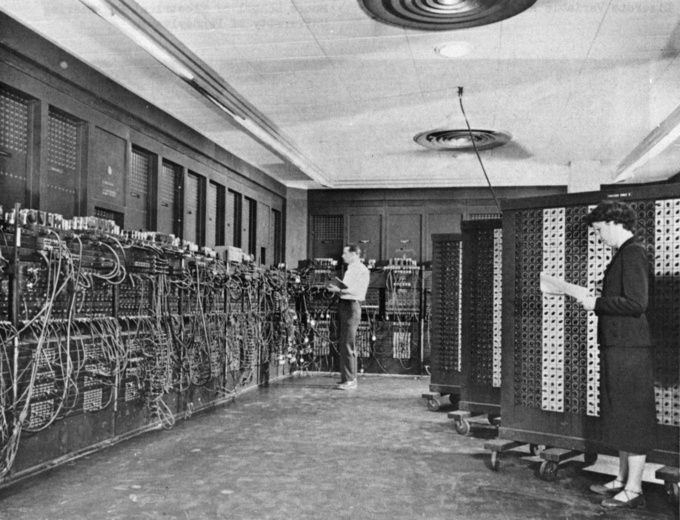
ENIAC: ENIAC, the first general purpose computer, was a technological advancement that affected both productivity and the types of outputs that could be produced.
In a developing country, the government works to ensure that the technologies, skills, knowledge, and methods of manufacturing are tested and developed so that they can be passed on to a broader audience. The expansion and sharing of technology leads to the further development of goods, processes, applications, materials, and services. All of these areas are critical to the advancement of an economy in the long-run.
The field of economics is constantly evolving as is the production of goods and services. In order to advance and continue to grow all markets need to make use of new technology to stay competitive. In the case of long-run economic growth, using the most advanced technology provides a market with a competitive advantage. Advances in technology creates an increased level of output with the same inputs, which improves productivity.
Government Activity
Government activity and policies have a direct impact on long-run growth. It can invest, and operate through monetary and fiscal policy.
learning objectives
- Discuss the long-run implications on growth from government policies
Economic Growth
In macroeconomics, long-run growth is the increase in the market value of goods and services produced by an economy over a period of time. The long-run growth is determined by percentage of change in the real gross domestic product (GDP). In order for an economy to experience positive long-run growth its outputs and inputs must be in balance for an increase to occur in supply, demand, revenue, and employment. The long-run economic growth is determined by short-run economic decisions.
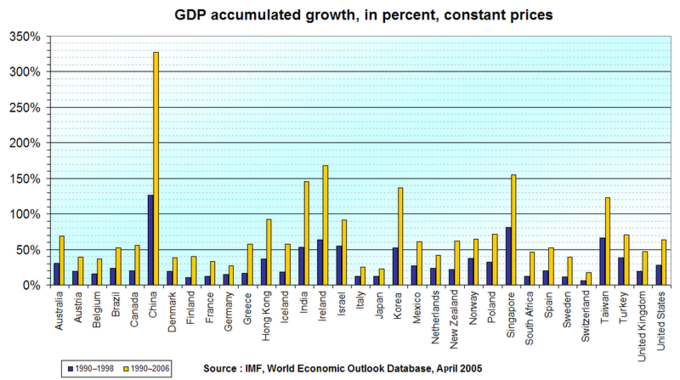
Gross Domestic Product: The change in GDP is used to determine economic growth within a country.
Government Activity
Government activity and policies have a direct impact on long-run growth. Long-run growth can be redirected and improved when changes are made to short-run actions. When an economy or industry experiences imbalanced in economic growth, the government can respond in order to assist in securing the market. Examples of possible government activity include:
- Investment: the government can stimulate economic growth by investing in the economy. Examples of stimulants include investing in market production, infrastructure, education, and preventative health care. This is especially important when excessive growth occurs. The government must stimulate economic growth to meet the needs of an increasing population.
- Monetary policy: the government enacts monetary policies to keep the growth rate of money steady. This helps to control excess inflation and excess short-term growth, both of which can negatively affect long-run growth. It’s important to note, however, that fiscal policy can also affect the level of inflation within an economy.
- Fiscal Policy: Choices in tax structure, government spending, and economic regulation can all impact long-run growth by affecting the choices that businesses and individuals make.
Government activity impacts long-run growth. It is critical that increasing populations have access to productive resources. It is also important that markets stay balanced in order to be successful and thrive.
Arguments in Favor and Opposed to Economic Growth
Economic growth has the potential to make all people richer, but may have downsides such as increased inequality and environmental impacts.
learning objectives
- Compare and contrast the consequences of economies in which growth is a goal
Economic Growth
Economic growth is defined as the increase in the market value of goods and services produced by an economy over a period of time. It is measured as the percentage increase in the real gross domestic product (GDP). In other words, economic growth is an expansion of the economic output of a country. Over the long-run economists might look at the per-capita rate of GDP growth (the growth of the ratio of GDP to the population).

GDP: The percentage increase in the GDP of a country is used to measure the country’s economic growth.
Arguments in Favor of Growth
There are numerous arguments in support of economic growth that describe its positive impact on society. Arguments in favor of economic growth include:
- Increased productivity: in countries that experience positive economic growth, the growth is often attributed to an increase in human and physical capital. Also, economic growth is usually accompanied by new and improved technological innovations.
- Expansion of power: economic growth is influential within a country even if the percentage of growth is small. With a small growth rate, a country will experience a substantial increase in power over the long-run. For example, a growth rate of 2.5% per annum leads to a doubling of the GDP within 29 years. In contrast, a growth rate of 8% per annum leads to a doubling of the GDP within 10 years. The power expansion associated with economic growth has long-run influences on a country.
- Quality of life: the quality of life increases in countries that experience economic growth. Economic growth alleviates poverty by increasing employment opportunities and labor productivity. It has been found that happiness increases with a higher GDP per capita, up to a level of at least $15,000 per person.
Arguments Opposed to Growth
There are a series of arguments that are opposed to economic growth. Arguments opposed to growth include:
- Resource depletion: economic growth has the potential to deplete resources if science and technology do not produce viable substitutes or new resources. Also, some arguments state that better technology and more efficient production will deplete resources quicker in the long-run even though advancements are perceived as positive right now.
- Environmental impact: some argue that a narrow view of economic growth combined with globalization could collapse the world’s natural resources. Portions of society have advocated the ideas of uneconomic growth and de-growth (economic contraction) in an attempt to lessen these effects of economic growth.
- Equitable growth: it has been found that while economic growth has a positive impact on society as a whole, it is common that poor sections of society are not able to participate in economic growth. Economic growth has many positive effects, but a society must not favor economic growth over solving pressing social issues such as poverty. For example, in a country with low inequality, a country with a growth rate of 2% per head and 40% of the population living in poverty can halve the poverty in 10 years. In contrast, if the same country has high inequality it will take nearly 60 years to achieve the same level of poverty reduction.
Key Points
- Economic growth is the increase in the market value of the goods and services that an economy produces over time. It is measured as the percentage rate change in the real gross domestic product ( GDP ).
- Determinants of long-run growth include growth of productivity, demographic changes, and labor force participation.
- When the economic growth matches the growth of money supply, an economy will continue to grow and thrive.
- Inflation occurs in an economy when the prices of goods and services continue to rise while the purchasing power decreases.
- When the GDP growth is only caused by increases in population, the growth is excessive.
- Aggregate production functions create an estimated framework to determine how much of an economies’ growth is related to changes in capital or changes in technology.
- The aggregate production function describes the boundary representing the limit of output attainable from each feasible combination of input.
- The aggregate production takes the physical outputs and inputs into account to determine the allocative efficiency of the economy as a whole.
- The long-run growth of a firm can change the scale of operations by adjusting the level of inputs that are fixed in the short-run, which shifts the production function upward as plotted against the variable input.
- Human capital is defined as the stock of competencies, skills, and knowledge that allows individuals to produce economic value.
- Human capital has been show to increase economic development, productivity growth, and innovation.
- When individuals and societies invest in human capital it strengthens the future of the long-run economic growth. The qualitative and quantitative progress of a country is inevitable when human development is a priority.
- When a society invests in human capital, it increases worker productivity and economic growth. Human capital grows cumulatively over a long period of time.
- Growth is defined as the increase in output per capita of a country over a long period of time. One primary factor that influences the growth of an economy is technological change.
- When looking at long-run growth, technological change in the economic environment makes production more or less efficient.
- Technology is defined as the making, modification, usage, and knowledge of tools, machines, techniques, systems, and methods of organization in order to solve a problem, improve a preexisting solution to a problem, or achieve a goal.
- The expansion and sharing of technology leads to the further development of goods, processes, applications, materials, and services. All of these areas are critical to the advancement of an economy in the long-run.
- Long-run growth is the increase in the market value of goods and services produced by an economy over a period of time.
- The government may choose to invest in projects that are associated with long-term growth, such as infrastructure.
- Monetary and fiscal policy are used to regulate the economy, economic growth, and inflation so that long-run growth is possible.
- Government activities used to improve long-run growth include stimulating economic growth, enacting monetary policies, fixing the exchange rates, and using wage and price controls.
- Over the long-run economic growth looks at the growth of the ratio of GDP to the population. Economic growth is an expansion of the economic output of a country.
- Arguments in support of economic growth include increased productivity, the expansion of power, and an increase in the quality of life.
- Arguments opposed to economic growth include resource depletion, environmental impacts, and equitable growth.
Key Terms
- inflation: An increase in the general level of prices or in the cost of living.
- economic growth: The increase of the economic output of a country.
- physical capital: A physical factor of production (or input into the process of production), such as machinery, buildings, or computers.
- human capital: The stock of competencies, knowledge, social and personality attributes, including creativity, embodied in the ability to perform labor so as to produce economic value.
- productivity: A ratio of production output to what is required to produce it (inputs).
- human capital: The stock of competencies, knowledge, social and personality attributes, including creativity, embodied in the ability to perform labor so as to produce economic value.
- technology: The study of or a collection of techniques.
- output: Production; quantity produced, created, or completed.
- monetary policy: The process by which the central bank, or monetary authority manages the supply of money, or trading in foreign exchange markets.
- quality of life: The general well-being of societies, including not only wealth and employment, but also the environment, physical and mental health, education, recreation and leisure time, and social belonging.
LICENSES AND ATTRIBUTIONS
CC LICENSED CONTENT, SPECIFIC ATTRIBUTION
- economic growth. Provided by: Wiktionary. Located at: en.wiktionary.org/wiki/economic_growth. License: CC BY-SA: Attribution-ShareAlike
- Population growth. Provided by: Wikipedia. Located at: en.Wikipedia.org/wiki/Population_growth. License: CC BY-SA: Attribution-ShareAlike
- Economic growth. Provided by: Wikipedia. Located at: en.Wikipedia.org/wiki/Economic_growth. License: CC BY-SA: Attribution-ShareAlike
- Inflation. Provided by: Wikipedia. Located at: en.Wikipedia.org/wiki/Inflati...conomic_growth. License: CC BY-SA: Attribution-ShareAlike
- Macroeconomics/Glossary. Provided by: Wikibooks. Located at: en.wikibooks.org/wiki/Macroec...s/Glossary%23L. License: CC BY-SA: Attribution-ShareAlike
- inflation. Provided by: Wiktionary. Located at: en.wiktionary.org/wiki/inflation. License: CC BY-SA: Attribution-ShareAlike
- US Historical Inflation Ancient. Provided by: Wikipedia. Located at: en.Wikipedia.org/wiki/File:US...on_Ancient.svg. License: CC BY-SA: Attribution-ShareAlike
- WeltBIPWorldgroupOECDengl. Provided by: Wikipedia. Located at: en.Wikipedia.org/wiki/File:We...upOECDengl.PNG. License: CC BY-SA: Attribution-ShareAlike
- Macroeconomics/Glossary. Provided by: Wikibooks. Located at: en.wikibooks.org/wiki/Macroec...s/Glossary%23A. License: CC BY-SA: Attribution-ShareAlike
- Production function. Provided by: Wikipedia. Located at: en.Wikipedia.org/wiki/Production_function. License: CC BY-SA: Attribution-ShareAlike
- Macroeconomics. Provided by: Wikipedia. Located at: en.Wikipedia.org/wiki/Macroec...3Growth_models. License: CC BY-SA: Attribution-ShareAlike
- Economic growth. Provided by: Wikipedia. Located at: en.Wikipedia.org/wiki/Economic_growth. License: CC BY-SA: Attribution-ShareAlike
- physical capital. Provided by: Wikipedia. Located at: en.Wikipedia.org/wiki/physical%20capital. License: CC BY-SA: Attribution-ShareAlike
- human capital. Provided by: Wikipedia. Located at: en.Wikipedia.org/wiki/human%20capital. License: CC BY-SA: Attribution-ShareAlike
- US Historical Inflation Ancient. Provided by: Wikipedia. Located at: en.Wikipedia.org/wiki/File:US...on_Ancient.svg. License: CC BY-SA: Attribution-ShareAlike
- WeltBIPWorldgroupOECDengl. Provided by: Wikipedia. Located at: en.Wikipedia.org/wiki/File:We...upOECDengl.PNG. License: CC BY-SA: Attribution-ShareAlike
- Total, Average, and Marginal Product. Provided by: Wikipedia. Located at: en.Wikipedia.org/wiki/File:To...al_Product.gif. License: Public Domain: No Known Copyright
- Economic growth. Provided by: Wikipedia. Located at: en.Wikipedia.org/wiki/Economi...tal_and_growth. License: CC BY-SA: Attribution-ShareAlike
- Human capital. Provided by: Wikipedia. Located at: en.Wikipedia.org/wiki/Human_capital. License: CC BY-SA: Attribution-ShareAlike
- Real income. Provided by: Wikipedia. Located at: en.Wikipedia.org/wiki/Real_income. License: CC BY-SA: Attribution-ShareAlike
- human capital. Provided by: Wikipedia. Located at: en.Wikipedia.org/wiki/human%20capital. License: CC BY-SA: Attribution-ShareAlike
- productivity. Provided by: Wikipedia. Located at: en.Wikipedia.org/wiki/productivity. License: CC BY-SA: Attribution-ShareAlike
- US Historical Inflation Ancient. Provided by: Wikipedia. Located at: en.Wikipedia.org/wiki/File:US...on_Ancient.svg. License: CC BY-SA: Attribution-ShareAlike
- WeltBIPWorldgroupOECDengl. Provided by: Wikipedia. Located at: en.Wikipedia.org/wiki/File:We...upOECDengl.PNG. License: CC BY-SA: Attribution-ShareAlike
- Total, Average, and Marginal Product. Provided by: Wikipedia. Located at: en.Wikipedia.org/wiki/File:To...al_Product.gif. License: Public Domain: No Known Copyright
- Distributed Intelligent Systems Department laboratory. Provided by: Wikipedia. Located at: en.Wikipedia.org/wiki/File:Di...laboratory.jpg. License: CC BY-SA: Attribution-ShareAlike
- Technology. Provided by: Wikipedia. Located at: en.Wikipedia.org/wiki/Technology. License: CC BY-SA: Attribution-ShareAlike
- Technology transfer. Provided by: Wikipedia. Located at: en.Wikipedia.org/wiki/Technology_transfer. License: CC BY-SA: Attribution-ShareAlike
- Economics. Provided by: Wikipedia. Located at: en.Wikipedia.org/wiki/Economi...Macroeconomics. License: CC BY-SA: Attribution-ShareAlike
- Technological change. Provided by: Wikipedia. Located at: en.Wikipedia.org/wiki/Technol...ge%23Economics. License: CC BY-SA: Attribution-ShareAlike
- technology. Provided by: Wiktionary. Located at: en.wiktionary.org/wiki/technology. License: CC BY-SA: Attribution-ShareAlike
- output. Provided by: Wiktionary. Located at: en.wiktionary.org/wiki/output. License: CC BY-SA: Attribution-ShareAlike
- US Historical Inflation Ancient. Provided by: Wikipedia. Located at: en.Wikipedia.org/wiki/File:US...on_Ancient.svg. License: CC BY-SA: Attribution-ShareAlike
- WeltBIPWorldgroupOECDengl. Provided by: Wikipedia. Located at: en.Wikipedia.org/wiki/File:We...upOECDengl.PNG. License: CC BY-SA: Attribution-ShareAlike
- Total, Average, and Marginal Product. Provided by: Wikipedia. Located at: en.Wikipedia.org/wiki/File:To...al_Product.gif. License: Public Domain: No Known Copyright
- Distributed Intelligent Systems Department laboratory. Provided by: Wikipedia. Located at: en.Wikipedia.org/wiki/File:Di...laboratory.jpg. License: CC BY-SA: Attribution-ShareAlike
- PPF expansion. Provided by: Wikipedia. Located at: en.Wikipedia.org/wiki/File:PPF_expansion.svg. License: CC BY-SA: Attribution-ShareAlike
- Eniac. Provided by: Wikipedia. Located at: en.Wikipedia.org/wiki/File:Eniac.jpg. License: CC BY: Attribution
- Economic growth. Provided by: Wikipedia. Located at: en.Wikipedia.org/wiki/Economic_growth. License: CC BY-SA: Attribution-ShareAlike
- economic growth. Provided by: Wiktionary. Located at: en.wiktionary.org/wiki/economic_growth. License: CC BY-SA: Attribution-ShareAlike
- monetary policy. Provided by: Wiktionary. Located at: en.wiktionary.org/wiki/monetary_policy. License: CC BY-SA: Attribution-ShareAlike
- Inflation. Provided by: Wikipedia. Located at: en.Wikipedia.org/wiki/Inflati...ling_inflation. License: CC BY-SA: Attribution-ShareAlike
- US Historical Inflation Ancient. Provided by: Wikipedia. Located at: en.Wikipedia.org/wiki/File:US...on_Ancient.svg. License: CC BY-SA: Attribution-ShareAlike
- WeltBIPWorldgroupOECDengl. Provided by: Wikipedia. Located at: en.Wikipedia.org/wiki/File:We...upOECDengl.PNG. License: CC BY-SA: Attribution-ShareAlike
- Total, Average, and Marginal Product. Provided by: Wikipedia. Located at: en.Wikipedia.org/wiki/File:To...al_Product.gif. License: Public Domain: No Known Copyright
- Distributed Intelligent Systems Department laboratory. Provided by: Wikipedia. Located at: en.Wikipedia.org/wiki/File:Di...laboratory.jpg. License: CC BY-SA: Attribution-ShareAlike
- PPF expansion. Provided by: Wikipedia. Located at: en.Wikipedia.org/wiki/File:PPF_expansion.svg. License: CC BY-SA: Attribution-ShareAlike
- Eniac. Provided by: Wikipedia. Located at: en.Wikipedia.org/wiki/File:Eniac.jpg. License: CC BY: Attribution
- Gdp accumulated change. Provided by: Wikipedia. Located at: en.Wikipedia.org/wiki/File:Gd...ted_change.png. License: CC BY-SA: Attribution-ShareAlike
- economic growth. Provided by: Wiktionary. Located at: en.wiktionary.org/wiki/economic_growth. License: CC BY-SA: Attribution-ShareAlike
- Economic growth. Provided by: Wikipedia. Located at: en.Wikipedia.org/wiki/Economi...ons_and_growth. License: CC BY-SA: Attribution-ShareAlike
- Economic growth. Provided by: Wikipedia. Located at: en.Wikipedia.org/wiki/Economi...ctivity_growth. License: CC BY-SA: Attribution-ShareAlike
- economic growth. Provided by: Wiktionary. Located at: en.wiktionary.org/wiki/economic_growth. License: CC BY-SA: Attribution-ShareAlike
- Degrowth. Provided by: Wikipedia. Located at: en.Wikipedia.org/wiki/Degrowth. License: CC BY-SA: Attribution-ShareAlike
- quality of life. Provided by: Wiktionary. Located at: en.wiktionary.org/wiki/quality_of_life. License: CC BY-SA: Attribution-ShareAlike
- US Historical Inflation Ancient. Provided by: Wikipedia. Located at: en.Wikipedia.org/wiki/File:US...on_Ancient.svg. License: CC BY-SA: Attribution-ShareAlike
- WeltBIPWorldgroupOECDengl. Provided by: Wikipedia. Located at: en.Wikipedia.org/wiki/File:We...upOECDengl.PNG. License: CC BY-SA: Attribution-ShareAlike
- Total, Average, and Marginal Product. Provided by: Wikipedia. Located at: en.Wikipedia.org/wiki/File:To...al_Product.gif. License: Public Domain: No Known Copyright
- Distributed Intelligent Systems Department laboratory. Provided by: Wikipedia. Located at: en.Wikipedia.org/wiki/File:Di...laboratory.jpg. License: CC BY-SA: Attribution-ShareAlike
- PPF expansion. Provided by: Wikipedia. Located at: en.Wikipedia.org/wiki/File:PPF_expansion.svg. License: CC BY-SA: Attribution-ShareAlike
- Eniac. Provided by: Wikipedia. Located at: en.Wikipedia.org/wiki/File:Eniac.jpg. License: CC BY: Attribution
- Gdp accumulated change. Provided by: Wikipedia. Located at: en.Wikipedia.org/wiki/File:Gd...ted_change.png. License: CC BY-SA: Attribution-ShareAlike
- Gdp accumulated change. Provided by: Wikipedia. Located at: en.Wikipedia.org/wiki/File:Gd...ted_change.png. License: Public Domain: No Known Copyright

